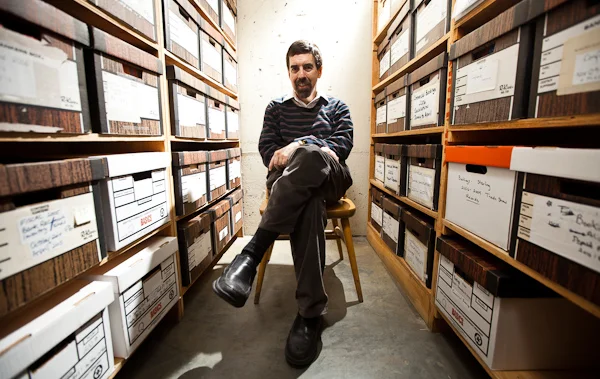
As UBC launched its Centennial year in 2015, the AMS’s longtime Archivist Sheldon Goldfarb was at work on a book that celebrates the essence and evolution of student experience and self-governance. The Great Trekking is the final product of this immersive inquiry into UBC’s cultural history and identity in the last century.
Goldfarb is the man behind the curtain of student union and the first stop for advice on UBC rules and bylaws. “I like research and I like answering questions,” said Goldfarb on qualities that landed him the position as an archivist of the AMS.
During his 23 years at the AMS, his role expanded from being in charge of records to drafting AMS code of procedure. Three years ago, he picked up the project on writing the centennial history of UBC.
The Great Trekking is named after the student-facilitated campaign in 1922 that took place as a movement toward the new site for UBC in Point Grey. The University of British Columbia was initially founded at Fairview in 1915, on the site of what is now Vancouver General Hospital. The university expanded rapidly in its first seven years: lecture halls became overcrowded and laboratory facilities were inadequate. A new campus site was necessary for more adequate facilities, but the government has ceased its funding due to WWI and economic restraints over the Great Depression Era.
Under the leadership of returned war veteran and AMS President-Elect Ab Richards, UBC students collected approximately 56,000 signatures over the summer break in support of building the university at the Point Grey site. This campaign culminated into a successful trek to raise public awareness about the plight of inadequate campus and frustration with government inaction.
1,200 students marched their way from the Fairview campus, travelling through downtown, over the Granville Street Bridge, up West 10th Avenue and finally up to the Point Grey site.
“It was the first successful student led event illustrating AMS’s independence from UBC. That’s something we are very proud of,” said Goldfarb.
The campaign swayed the provincial government to raise $1.5 million to construct permanent buildings on the site. The AMS continued to campaign and fundraise for non-academic buildings on campus, which led to the construction of Brock Hall (1940), War Memorial Gymnasium (1951), the Student Union Building (1968), the Old UBC Aquatic Center (1978) and the Nest (2015).
“One thing I noticed while going through the records was that things are really different back then,” said Goldfarb. “There was a lot of hazing where people are told to crawl on their knees. In the book, there is even a picture of guy hooked to a battery, though I’m sure he wasn’t hurt badly. Imagine day is certainly nothing compared to the past.”
Most of the changes took shape in the 1960’s. The new wave of cultural dissent was the turning point where student government rose to prominence, pushing for more weight in administrative decision. The counterculture also sought to offer alternatives to patriarchal social structures, unquestioning support for the United States and tradition idea of love and marriage.
“A lot of things changed in the 60’s; it was a wild era, culturally and politically,” said Goldfarb.
At UBC, Jerry Rubin urged 1,500 students to liberate themselves from all forms of establishment. The students occupied the Faculty Club, emptied the faculty’s liquor cabinet, smoked their cigarettes, burned an American flag and swam nude in the patio pool. The sprawl was the largest display of UBC student power since the 1922 Great Trek, ultimately giving students more say in how the university was run.
Students were given an increased role in UBC’s governing bodies: the number of students on the university’s senate increased from four to 12, and two students were elected to UBC’s board of governors for the first time.
The era of 2000’s saw substantial advancements in labs and classrooms that aim to affect the world, not solely on an intellectual scale but also in the commercial arena. To date, UBC has seen 169 spin-off companies. More condos and market housing would rise on the university’s endowment lands, which later developed into a series of residential neighbourhoods around the campus. They are named after the first university president Frank Wesbrook.
The AMS has also evolved with employment programs that cater to student needs, such as AMS tutoring and Safewalk.
Nonetheless, a lot of things are still the same.
“Both UBC and AMS are at constant shortage of money to complete their mission. Students always protest about the increase in tuition fees, cost of housing, not enough housing and the cafeteria food,” said Goldfarb.
Now entering into its second century, UBC continues to be a place of mind — resilient, agile and curious. From the Fairview shacks to an incubator for innovation, The Great Trekking chronicles the plethora of ways in which UBC, AMS and its alumni have paved the path for the present.

